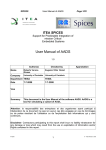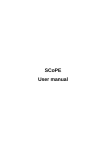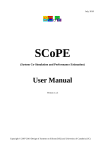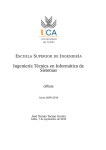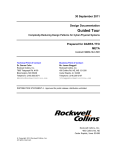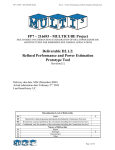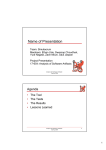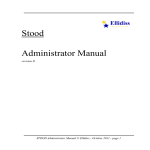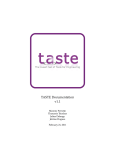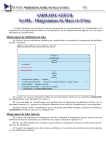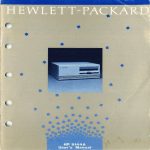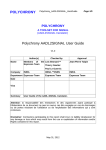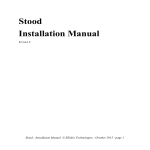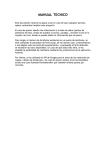Download User Manual of AADS-T
Transcript
User Manual of AADS-T
HWSWCO
Page 1/39
HARDWARE SOFTWARE CODESIGN
User Manual of AADS-T
1.4
Author(s)
Checked by
Name
Roberto Varona
Gómez
Eugenio Villar Bonet
Company
University of Cantabria
University of Cantabria
Department TEISA
TEISA
Date
31-5-2011
31-5-2011
Approbation
Visa
Summary
31/5/2011
This document is the User Manual of the software AADS-T. AADS-T is
a tool for simulating a subset of AADL including its Behavioural
Annex. The source code produced by AADS-T is Ravenscar
Computational Model (RCM) compliant.
1
© - University of Cantabria - 2011
HWSWCO
User Manual of AADS-T
Page 2/39
Table of Contents
1
Preface ........................................................................................................................4
1.1 Table of versions ...................................................................................................4
1.2 Table of references and applicable documents .....................................................4
1.3 Acronyms and glossary .........................................................................................4
2
Subject ........................................................................................................................6
2.1 Purpose of the document ......................................................................................6
2.2 Editing particularities .............................................................................................6
2.2.1 Temporary editing ..........................................................................................6
2.3 Application scope ..................................................................................................6
3
What does AADS-T do? ..............................................................................................7
4
Installation of AADS-T .................................................................................................9
5
Use of AADS-T..........................................................................................................10
6
Relation with SCoPE .................................................................................................17
7
Ravenscar Computational Model compliant ..............................................................23
7.1 Basic elements ....................................................................................................23
7.2 Properties of threads ...........................................................................................23
7.3 Properties of protected objects............................................................................24
7.4 Scheduling...........................................................................................................25
Annex I: Subset of AADL and Behavioral Annex. ..............................................................27
I.1
AADL ...................................................................................................................27
I.2
Behavioral Annex ................................................................................................28
Annex II: License. ..............................................................................................................30
II.1 GNU GENERAL PUBLIC LICENSE ........................................................................30
II.1.1 Preamble ..........................................................................................................30
II.1.2 TERMS AND CONDITIONS.............................................................................31
31/5/2011
2
© - University of Cantabria - 2011
HWSWCO
User Manual of AADS-T
Page 3/39
Index of Figures
Figure 1. Relationship among OSATE, AADS-T and SCoPE. .............................................8
Figure 2. Menu bar of OSATE with button and entry for AADS. ........................................10
Figure 3. Initial information window of AADS-T..................................................................10
Figure 4. Selection of the un-instantiated AADL XML file. .................................................11
Figure 5. Selection of the instantiated AADL XML file. ......................................................12
Figure 6. Information in console of OSATE........................................................................13
Figure 7. Start information window of SCoPE....................................................................14
Figure 8 Warning window SCoPE un-installed. .................................................................14
Figure 9. End information window of SCoPE. ....................................................................15
Figure 10. Part of the SCoPE output in the console of OSATE. ........................................16
31/5/2011
3
© - University of Cantabria - 2011
User Manual of AADS-T
HWSWCO
1
Preface
1.1
Table of versions
Version
1.0
Date
Page 4/39
Description & rationale of
modifications
Sections modified
10/11/2010
First version
1.1
21/1/2011
AADS-T now runs under Linux. AADS-T Cover, 1.1, 2.1, 2.3,
launches SCoPE automatically. The
3, 4, 5, 6, 7, Annex
synchronization operation of the
I.
protected objects has been modified to
use a conditional variable instead of a
clock_nanosleep. The .txt and .xml files
will be generated from SCoPE’s output.
Grammatical corrections.
1.2
8/2/2011
Install AADS-T as a real plug-in.
1.3
11/2/2011
Warning window if SCoPE un-installed. Cover, 1.1, 5.
Rename AADS-T Console. Warning if
no connections defined in AADL model.
1.4
31/5/2011
Automatic generation of make files,
modify copia_SCoPE and .bashrc
1.2
All
Cover, 1.1, 4, 5, 6.
Cover, 1.1, 6
Table of references and applicable documents
Reference
Title & edition
Author or editor
Year
[1]
Architecture analysis & design language (AADL), SAE AS2C
AS5506, v1.0
2004
[2]
The Architecture Analysis & Design Language
(AADL): An introduction.
P. Feiler, D. Gluch, J.
Hudak
2006
[3]
POSIX de Tiempo Real.
Michael González
Harbour
2004
[4]
An Extensible Open Source AADL Tool
Environment (OSATE).
SEI
2006
[5]
R1-4 Evaluation of Compliance with the ASSERT J. A. de la Puente
Process
J. Zamorano
2010
[6]
Annex Behaviour specification v 2.0
2007
1.3
31/5/2011
SAE AS5506
Acronyms and glossary
Term
Description
AADL
Architecture and Analysis Design Language
4
© - University of Cantabria - 2011
HWSWCO
31/5/2011
User Manual of AADS-T
Page 5/39
Term
Description
AADS-T
AADL Simulator for TASTE
DMA
Direct Memory Access
ESTEC
European Space Research and Technology Centre
FTP
File Transfer Protocol
GNU
GNU is Not Unix
GPL
General Public License
MPSoC
Multi Processor System-on-Chip
NoC
Network on Chip
OSATE
Open Source AADL Tool Environment
POSIX
Portable Operating System Interface
RCM
Ravenscar Computational Model
RTOS
Real Time Operating System
SAX
Simple API for XML
SCoPE
System Co-simulation & Performance Estimation
TEISA
Electronics Technology, Systems and Automation Engineering
Department
UTF
Unicode Transformation Format
W3C
World Wide Web Consortium
WIPO
World Intellectual Property Organization
XML
eXtensible Markup Language
5
© - University of Cantabria - 2011
HWSWCO
User Manual of AADS-T
2
Subject
2.1
Purpose of the document
Page 6/39
The purpose of the document is to describe the User Manual of the software tool
AADS-T. This tool will consistently provide, in accordance with a subset of the AADL
standard and the Behavioral Annex, the capability to simulate an AADL model using the
SCoPE tool. The source code produced by AADS-T is RCM-compliant. This document
specifies the usage and the general characteristics of the AADS-T tool.
2.2
Editing particularities
2.2.1 Temporary editing
Special points are signalled like this:
. ***temporary***
. ***incomplete***
. ***to be defined***
. ***to be confirmed***
2.3
Application scope
The application scope of this document is the ESTEC 22810/09/NL/JK HW-SW
CODESIGN project contracted to GMV Aerospace and Defense S.A.U. and partly
outsourced to the University of Cantabria. More specifically this User Manual is an activity
of Work Package 310 of the project, titled System-Level Performance Tool
Implementation.
31/5/2011
6
© - University of Cantabria - 2011
HWSWCO
3
User Manual of AADS-T
Page 7/39
What does AADS-T do?
The AADS-T tool enables the modeling of a subset of AADL including the
Behavioral Annex for purposes of implementation and simulation. The starting point of the
simulator will be an AADL specification. This AADL specification must contain a minimum
functionality described by means of some AADL properties in order to enable a proper
simulation of the model. The AADL model will be parsed by AADS-T and a model defined
with POSIX / C++ and XML will be obtained. This model will be simulated in order to check
whether the AADL constraints are fulfilled. As the design process advances and the real
functionalities are attached to the software components using the corresponding source
code, the value of these properties will be refined. These refined properties will be added
to the AADL model and a new model will be generated by AADS-T to check if the
constraints are still fulfilled.
When the AADS-T tool is initiated it requests the name of two AADL XML files. One of
these files is just the AADL model written in XML. The other is the result of an instantiation
of a system implementation of a textual or object AADL model obtained with OSATE, a
plug-in of the Eclipse platform used to process AADL models (see Figure 1). These files
are written in XML as they are easier to analyze using AADS-T because of the use of SAX.
Files containing the actual source code of the subprograms of the AADL model can be
supplied to AADS-T, although it is not mandatory. If they are supplied, the simulation and
performance analysis done with SCoPE will be more realistic, as this source code is
embedded in the POSIX / C++ files generated by AADS-T.
Once the XML files have been parsed by AADS-T, files written in C++ with the extensions
.h and .cpp and one XML file are created. The number and names of the files created
depend on the AADL model parsed. The C++ files use POSIX functions and the XML file
must be as specified to be used by the SCoPE tool. The source code in C++ produced by
AADS-T is compatible with the RCM.
AADS-T offers the possibility to the user of launching the SCoPE tool automatically. If the
user launches SCoPE from AADS-T, AADS-T generates one .txt file and one .xml file from
the output of SCoPE, containing the most important data about the simulation and
performance analyses such as use of CPU, core energy consumed, number of instructions
executed and others.
Moreover, a file is generated with the SystemC description of the AADL model.
31/5/2011
7
© - University of Cantabria - 2011
HWSWCO
User Manual of AADS-T
Page 8/39
Figure 1. Relationship among OSATE, AADS-T and SCoPE.
31/5/2011
8
© - University of Cantabria - 2011
HWSWCO
4
User Manual of AADS-T
Page 9/39
Installation of AADS-T
The AADS-T tool will be delivered as a plug-in of the Eclipse platform (see more
about Eclipse at www.eclipse.org). This means that it will be necessary to install OSATE (a
plug-in of the Eclipse platform) to run AADS-T as a button in the toolbar. Now AADS-T
runs under Linux, so the latest stable version of OSATE for Linux must be downloaded
from www.aadl.info to install AADS-T.
You must download the file “uc.hwswco.sw.1.1-updatesite.zip” delivered by the TEISA
department of the University of Cantabria through the Web www.teisa.unican.es/AADS.
Before installing AADS-T, you must run OSATE on the computer. Then you must choose
on OSATE “Help”, then “Software Updates”, then “Find and Install…”, then check “Search
for new features to install”, then “Next >”, then “New Archived Site…” and then you choose
the file “uc.hwswco.sw.1.1-updatesite.zip” downloaded. You must check the recently
created site and choose “Next >”, Then accept the AADS-T plug-in license agreement and
select “Next >”. Select the “Finish” option. The AADS-T tool is ready to be installed, so
select “Install All”. The plug-in will be installed and then you will be prompted to restart
OSATE. When OSATE is restarted the plug-in will have been installed correctly.
31/5/2011
9
© - University of Cantabria - 2011
User Manual of AADS-T
HWSWCO
5
Page 10/39
Use of AADS-T
First of all OSATE must be initiated. It contains a button of AADS and an entry in the menu
bar for AADS (see Figure 2, the window is cut off in this document for better legibility):
Figure 2. Menu bar of OSATE with button and entry for AADS.
When you click on this button or on the menu bar, the tool AADS-T starts. A new window
opens showing a message about the version, web, author, warranty and so on (see Figure
3, split into two in this document for better legibility):
Figure 3. Initial information window of AADS-T.
If the user clicks the Cancel button, AADS-T returns to the previous state. If the user clicks
the OK button, two windows appear successively asking for the name of the uninstantiated AADL file written in XML to be parsed such as for example cruise_control.aaxl
(see Figure 4).
31/5/2011
10
© - University of Cantabria - 2011
HWSWCO
User Manual of AADS-T
Page 11/39
Figure 4. Selection of the un-instantiated AADL XML file.
The user can choose an .aaxl file and click on the Aceptar (Accept) button or click on the
Cancelar (Cancel) button. In this last case AADS-T terminates and shows in the console of
OSATE the message:
Exception1 org.xml.sax.SAXParseException: File "" not found.
If a correct file has been selected, AADS-T parses the file and two windows appear
successively asking for the name of the instantiated AADL file written in XML to parse, for
example cruise_control_Cruisecontrol_Generic_Instance.aaxl (see Figure 5).
31/5/2011
11
© - University of Cantabria - 2011
HWSWCO
User Manual of AADS-T
Page 12/39
Figure 5. Selection of the instantiated AADL XML file.
The user can choose an .aaxl file and click on the Aceptar (Accept) button or click on the
Cancelar (Cancel) button. In the latter case AADS-T terminates and shows in the console
of OSATE the message:
Exception1 org.xml.sax.SAXParseException: File "" not found.
If a correct file has been selected, AADS-T parses the file and produces some files written
in C++ (files with extension .cpp and .h) complying with POSIX standard, compatible with
the RCM, and an XML file. These files are in the working directory and can be used with
the SCoPE tool.
The console of OSATE shows some information about the process if this is successful
(see Figure 6, the window is cut in this document for better legibility):
31/5/2011
12
© - University of Cantabria - 2011
HWSWCO
User Manual of AADS-T
Page 13/39
Figure 6. Information in console of OSATE.
If a file to be parsed is not in the proper format, AADS-T will show the following error
messages in the console of OSATE (it is an example, it depends on the file) and will
terminate:
Exception1 org.xml.sax.SAXParseException: The root element is required in a
well-formed document.
(...)
Exception1 org.xml.sax.SAXParseException: The markup in the document preceding
the root element must be well-formed.
java.lang.NullPointerException
at parser.EscrituraFichero.HWComponent(EscrituraFichero.java:275)
at parser.EscrituraFichero.GeneraXML(EscrituraFichero.java:212)
at parser.EscrituraFichero.stringToFile(EscrituraFichero.java:107)
at parser.Parseador.endDocument(Parseador.java:88)
at org.apache.xerces.parsers.SAXParser.endDocument(SAXParser.java:1230)
at
org.apache.xerces.validators.common.XMLValidator.callEndDocument(XMLValidator.ja
va:1146)
at
org.apache.xerces.framework.XMLDocumentScanner$EndOfInputDispatcher.dispatch(XML
DocumentScanner.java:1499)
at
org.apache.xerces.framework.XMLDocumentScanner.parseSome(XMLDocumentScanner.java
:381)
at org.apache.xerces.framework.XMLParser.parse(XMLParser.java:1098)
at org.apache.xerces.framework.XMLParser.parse(XMLParser.java:1139)
at parser.Index.ParsearDocumento(Index.java:40)
at parser.Index.main(Index.java:61)
If the AADL model translated by AADS-T has no connections defined, the message
“Warning: There are no connections defined in the AADL model.” is shown in the AADS-T
Console.
If the generation of the POSIX / C++ and XML files has been correct, AADS-T will show
31/5/2011
13
© - University of Cantabria - 2011
HWSWCO
User Manual of AADS-T
Page 14/39
the following window to offer the user the possibility of launching SCoPE automatically to
simulate and analyze the performance of the model (see Figure 7, split into two in this
document for better legibility):
Figure 7. Start information window of SCoPE.
If the user clicks on the Cancel button SCoPE is not launched and AADS-T returns to the
initial state. If the user clicks on the OK button, the files generated by AADS-T are
compiled and SCoPE is launched to simulate the model. This takes some minutes.
If SCoPE is not correctly installed, AADS-T shows a warning window (see Figure 8) and
returns to the initial state without launching SCoPE.
Figure 8 Warning window SCoPE un-installed.
If SCoPE is correctly installed, when the simulation has been made AADS-T shows a final
window (see Figure 9) and generates a .txt file and an .xml file containing the more
relevant results of the simulation done to permit the performance analysis.
31/5/2011
14
© - University of Cantabria - 2011
HWSWCO
User Manual of AADS-T
Page 15/39
Figure 9. End information window of SCoPE.
If the simulation has been done correctly, AADS-T shows in the console of OSATE the
output of SCoPE. There is part of an example in Figure 10:
31/5/2011
15
© - University of Cantabria - 2011
HWSWCO
User Manual of AADS-T
Page 16/39
Figure 10. Part of the SCoPE output in the console of OSATE.
31/5/2011
16
© - University of Cantabria - 2011
HWSWCO
6
User Manual of AADS-T
Page 17/39
Relation with SCoPE
The AADS-T tool creates files written in C++ with the extensions .h and .cpp, compatible
with the RCM, and one file written in XML. The number and names of the files created
depends on the model AADL parsed. These files are used by SCoPE as we can see in
Figure 1 to simulate the model. Therefore, the structure that these files have and functions
supported by SCoPE must be known by AADS-T. AADS-T produces files to be used with
the SCoPE tool, so the relationship between AADS-T and SCoPE is dependence of the
former on the latter.
The XML file generated by AADS-T to be used by SCoPE as a configuration file follows
the 1.0 standard of W3C and uses UTF-8 encoding. The hardware architecture is
structured through the XML file generated by AADS-T. It is used as part of the
configuration parameters of SCoPE and is divided into: HW_Platform, SW_Platform and
Application.
•
HW_Platform. Any AADL implementation of a processor, memory, bus or device
must be specified with its category and name in the HW_Components subsection of
HW_Platform. The AADL property Assign_Byte_Time is used to set the frequency
parameter in the XML file. For memories we use the properties Access_Time or
Read_Time and Write_Time. These properties have their values in time units (ns,
ms and so on) and they must be transformed into MHz. To know the mem_size of a
memory, both Word_Count and Word_Size AADL properties are required. Finally
the mem_type of a memory is derived from Memory_Protocol in the AADL model. If
the component is a processor, proc_type must be specified.
The HW_Architecture and Computing_groups subsections of HW_Platform are next
in the XML file. To know the start_addr of a memory we take the AADL property
Base_Address. To know the start_addr of a device we take the AADL property
UC::Base_Address_Devices. The component and name are inferred from the AADL
model. Hardware components are grouped by buses as they are connected to them
in AADL through the connections bus access and the features requires bus access.
•
SW_Platform. This section has two subsections: SW_Components and
SW_Architecture. This section takes into account the buses that are defined to
make the equivalent nodes. In this section the operating systems are specified.
•
Application. This section has two subsections: Functionality and Allocation. Filling
the Functionality section is straightforward from the AADL model using the property
of a thread Activate_Entrypoint for the function and Source_Text for the file. The
name is the same as the one of the thread. For the Allocation section we need to
know the property of a thread Actual_Processor_Binding, and find out which bus
the processor is bound to and then find out which node that bus corresponds to.
The AADL name of the thread is used for the name and the component.
Before using SCoPE, it must be installed, compiled and linked on the Linux host where
AADS-T is installed. For more information about SCoPE you can visit
www.teisa.unican.es/scope.
Two make files are generated automatically by AADS-T to compile and link the files
created by AADS-T with the ones of SCoPE. One file is on the working directory of the xml
31/5/2011
17
© - University of Cantabria - 2011
HWSWCO
User Manual of AADS-T
Page 18/39
plug-in of SCoPE. AADS-T uses the file Makefile_Template_Prueba that must be in the
directory named in AADS_WORKSPACE (see later), as a basis to generate the make file.
AADS-T replaces the label XML_XML_XML to use the corresponding configuration XML
file of the specific model. Here is this file Makefile_Template_Prueba:
all:
$(SCOPE_XML_PLUGIN)/build/scope_tool.x -xml XML_XML_XML.xml -sc
cp sc_main.cpp scope/sc_main.cpp
make all -C scope
sc_main:
$(SCOPE_XML_PLUGIN)/build/scope_tool.x -xml XML_XML_XML.xml -sc
clean:
rm -f *.o *.so *.x *.ii *.tmp
make clean -C scope
rm -f scope/sc_main.cpp
rm -f sc_main.cpp
run: all
make run -C scope
distclean:
rm -f *.x
The other make file is on the scope directory that is on the working directory of the xml
plug-in of SCoPE. AADS-T uses the file Makefile_Template_Scope that must be in the
directory named in AADS_WORKSPACE (see later), as a basis to generate the make file.
AADS-T replaces the label MAIN_MAIN_MAIN to use the corresponding main C++ file of
the specific model. AADS-T replaces the label GNAT_GNAT_GNAT with the directory
named in GNAT_FOR_LEON (see later). AADS-T adds the corresponding lines to compile
and link the different C++ files. Here is this file Makefile_Template_Scope:
# SCoPE options:
SCOPE_CXX = scope-g++
SPARC_COMPILER = "sparc-elf-gcc -isystem GNAT_GNAT_GNAT/bin/../lib/gcc/sparcelf/4.1.3/include/ -isystem GNAT_GNAT_GNAT/sparc-elf/include/ -isystem
GNAT_GNAT_GNAT/sparc-elf/include/sys -isystem /usr/include -D_POSIX_THREADS D_POSIX_THREAD_PRIORITY_SCHEDULING -D_POSIX_THREAD_PRIO_PROTECT -D_POSIX_TIMERS
-D_LEON_2 -D'sched_setaffinity(...)' -D'sched_getaffinity(...)'"
SCOPE_FLAGS = --scope-method=asm-opcodes --scope-crosscompiler=$(SPARC_COMPILER)
--scope-cpu=LEON2 --scope-nodcache --scope-preserve-files #--scope-verbose scope-method=op-cost --scope-preserve-files --scope-crosscompiler=arm-linux-gcc
--scope-method=asm-sentences --scope-language=c
SCOPE_FLAGS_2 = --scope-method=asm-opcodes --scopecrosscompiler=$(SPARC_COMPILER) --scope-cpu=FPGA --scope-nodcache --scopepreserve-files #--scope-verbose -scope-method=op-cost --scope-preserve-files -scope-crosscompiler=arm-linux-gcc --scope-method=asm-sentences --scopelanguage=c
SCOPE_INC_DIR = -I$(SCOPE_HOME)/scope \
-I$(SYSTEMC)/include \
-I$(SCOPE_HOME)/TLM2/include/tlm \
-I$(SCOPE_HOME)/tinyxml \
31/5/2011
18
© - University of Cantabria - 2011
HWSWCO
User Manual of AADS-T
-I$(SCOPE_HOME)/scope \
-I$(SCOPE_HOME)/scope/hal
-I$(SCOPE_HOME)/scope/rtos/api/posix
-I$(SCOPE_HOME)/scope/rtos/api/ucos
-I$(SCOPE_HOME)/scope/rtos/drivers
-I$(SCOPE_HOME)/scope/rtos/kernel
-I$(SCOPE_HOME)/scope/rtos/low_level
-I$(SCOPE_HOME)/scope/rtos/qt_interface
-I$(SCOPE_HOME)/scope/rtos/utils
-I$(SCOPE_HOME)/scope/sicosys/SC_Simul
-I$(SYSTEMC)/include
-I$(SYSTEMC)/src/sysc/qt
\
-I$(SCOPE_HOME)/TLM2/include/tlm \
-I$(SCOPE_SMPSIM_PLUGIN)/include
Page 19/39
\
\
\
\
\
\
\
\
\
\
# Compiler options:
CXX = g++
DEBUG = -g
OPT = -O0
CFLAGS = $(DEBUG) $(OPT) -c
INC_DIR = $(addprefix -I,$(LOCAL_INC_DIRS)) $(SCOPE_INC_DIR)
LIB_DIR = -L$(SYSTEMC)/lib-linux -L$(SCOPE_HOME)/scope L$(SCOPE_HOME)/scope/sicosys/SC_Simul -L$(SCOPE_HOME)/tinyxml L$(SCOPE_SMPSIM_PLUGIN)/lib -L.
LIB = -rdynamic -lscope -ltinyxml -lsystemc -lpthread -lrt -latcs -ldl
SRCS_CPP = MAIN_MAIN_MAIN.cpp devices.cpp
OBJS_CPP = $(SRCS_CPP:.cpp=.o)
OUT = MAIN_MAIN_MAIN.x
.PHONY:all $(OUT)
all:$(OUT)
# Link:
$(OUT): $(OBJS_CPP) sc_main.o
$(CXX) $(LIB_DIR) $(OBJS_CPP) sc_main.o -o $@ $(LIB)
# Parse and compile software application files:
MAIN_MAIN_MAIN.o: MAIN_MAIN_MAIN.cpp
$(SCOPE_CXX) $(SCOPE_FLAGS) $(CFLAGS) $(INC_DIR) $(SCOPE_INC_DIR) $^ -o
$@
devices.o: devices.cpp
$(SCOPE_CXX) $(SCOPE_FLAGS) $(CFLAGS) $(INC_DIR) $(SCOPE_INC_DIR) $^ -o
$@
# Compile sc_main.cpp with standar g++
sc_main.o : sc_main.cpp
$(CXX) $(CFLAGS) $(SCOPE_INC_DIR) $^ -o $@
# Clean:
.PHONY: clean distclean run
run: $(OUT)
./MAIN_MAIN_MAIN.x
clean:
31/5/2011
19
© - University of Cantabria - 2011
HWSWCO
rm
rm
rm
rm
User Manual of AADS-T
Page 20/39
-rf $(OBJS_CPP) sc_main.o
-f *.so
-f *~
-rf *.ii rm*.s rm table_* prsd_* asm_* uc_*
distclean: clean
rm -rf $(OUT)
AADS-T uses three files that are in the working directory of AADS-T, when the user
confirms the launching of SCoPE: copia_SCoPE, compila_SCoPE and run_SCoPE. The
first is made to copy the .cpp, .h and .xml files generated by AADS-T to the working
directory of the xml plug-in of SCoPE, and to generate the sc_main.cpp file (a SystemC file
with the description of the model). Here is an example (some parts such as the name of
the .xml file may have to be changed for the specific model):
cd $AADS_WORKSPACE
cp *.cpp $SCOPE_XML_PLUGIN/examples/prueba
cp *.cpp $SCOPE_XML_PLUGIN/examples/prueba/scope
cp *.h $SCOPE_XML_PLUGIN/examples/prueba
cp *.h $SCOPE_XML_PLUGIN/examples/prueba/scope
cp *.xml $SCOPE_XML_PLUGIN/examples/prueba
cp *.xml $SCOPE_XML_PLUGIN/examples/prueba/scope
cd $SCOPE_XML_PLUGIN/examples/prueba
$SCOPE_XML_PLUGIN/build/scope_tool.x -xml
cruise_control_Cruisecontrol_Generic_Instance.xml -sc
cp sc_main.cpp scope/sc_main.cpp
The second file, compila_SCoPE, is made to compile all the files generated by AADS-T
and generate the .x file (the executable file):
cd $SCOPE_XML_PLUGIN/examples/prueba
make all -C scope
The third file, run_SCoPE, is made to run SCoPE and to generate the file with the output
of SCoPE (it shows the number of thread and context switches, use of cpu, running time,
etc.) to generate the .txt and .xml files later:
cd $SCOPE_XML_PLUGIN/examples/prueba
make run -C scope > borame.txt
cp borame.txt $AADS_WORKSPACE/borame.txt
You must be aware of the SCOPE_XML_PLUGIN, AADS_WORKSPACE,
GNAT_FOR_LEON, etc. variables defined in the .bashrc file of your computer. For
example they could be:
export CXX=g++
export SYSTEMC=/home/roberto/systemc
export TLM2=/home/roberto/TLM
export DS2_CXX=g++
export SCOPE_HOME=/home/roberto/scope_repo
export PATH=$PATH:$SCOPE_HOME/bin
export
SCOPE_XML_PLUGIN=/home/roberto/scope_xml_plugin_repo/branches/scope_xml_systemc/
scope_xml_plugin
31/5/2011
20
© - University of Cantabria - 2011
HWSWCO
User Manual of AADS-T
Page 21/39
export SCOPE_PROJECT=cr.scope
export SCOPE_CPU=LEON2
export PATH=$PATH:/home/roberto/gnatforleon-2.1.0/bin
export PATH=$PATH:/home/roberto/jre1.6.0_23/bin
export PATH=$PATH:/home/roberto/osate-topcased-1.5.8.201006182029PRDlinux.gtk.x86/eclipse
export AADS_WORKSPACE=/home/roberto/osate-topcased-1.5.8.201006182029PRDlinux.gtk.x86
export GNAT_FOR_LEON=/home/roberto/gnatforleon-2.1.0
The SCoPE tool provides the technology to perform MPSoC HW/SW co-simulation with
NoC (Network on Chip). It obtains results for exploring the design space to choose the
right processors and HW/SW partition for embedded systems. It also allows the simulation
of different nodes connected through a NoC in order to analyse the behaviour of large
systems. Commonly, these tools are based on slow ISSs. The differentiating feature of this
technique is that SCoPE obtains the performance estimations at source code level. This
level of abstraction allows the simulation time to be reduced significantly while maintaining
good accuracy.
SCoPE is a C++ library that extends, without modification, the standard language
SystemC to perform the co-simulation. On the one hand, it simulates C/C++ software code
based on two different operating system interfaces (POSIX and MicroC/OS). On the other
hand, it co-simulates these pieces of code with hardware described in SystemC.
An engineer with this tool can simulate specific software on a custom platform and obtain
estimations of: Number of thread and context switches, running time and use of CPU,
instructions executed and cache misses, energy and power (of core and instruction
cache).
This library models the detailed behaviour of the RTOS including concurrency (among
tasks in the same processor), parallelism (among tasks in different processors),
scheduling and synchronization. Although the SystemC kernel executes processes
following a non pre-emptive scheduling policy without priorities, SCoPE models preemption under different scheduling policies based on priorities.
SCoPE integrates a POSIX-based API that enables the execution of many software
applications that fulfil this standard. POSIX is the main operating system interface
nowadays, but it is not the only one. Thus, SCoPE has been improved to support
extensions for other types of interfaces. An example is the integration with the MicroC/OS
interface. This is a demonstration of the scalability of the tool, in terms of software support.
The design of embedded systems requires not only software handling but also hardware
communication. For this reason SCoPE includes a set of more than a hundred driver
facilities to implement this communication. One of the most extensively used operating
systems in this sector is Linux, thus this driver facilities are based on the Linux kernel
version 2.6. Furthermore, SCoPE is able to simulate the loading of kernel modules and the
handling of hardware interruptions and their corresponding scheduling.
SystemC is the language used for the modelling of the hardware platform due to the
easiness of implementation (C++ extension) and its simulation kernel. For the purpose of
simulating different platforms, SCoPE incorporates some generic hardware modules: a
bus based on TLM2 used for the communication with peripherals and the transmission of
31/5/2011
21
© - University of Cantabria - 2011
HWSWCO
User Manual of AADS-T
Page 22/39
hardware interruptions, a DMA for copying large amounts of data, simple memory for the
simulation of cache and DMA traffic, a hardware interface for simple custom hardware
connection, a network interface that works as a net card for the NoC and an external
network simulator to implement the NoC connected to SCoPE.
System simulation comprises Multicomputation and Modular structure. Multicomputation:
One of the advantages of this tool is the possibility of interconnection among independent
nodes and simulating the interaction among them. Modular structure: Each RTOS
component is an independent object that does not share any data with the others.
Furthermore, each process is isolated from the rest of the system, thus a process with
global variables can be replicated in many nodes without data collision problems. That is,
each process has a separate memory space.
31/5/2011
22
© - University of Cantabria - 2011
HWSWCO
7
User Manual of AADS-T
Page 23/39
Ravenscar Computational Model compliant
The real-time behavior specification of ASSERT models is based on the RCM, a model of
concurrency for high-integrity systems that enables formal analysis of the temporal
properties of a system using response-time analysis techniques. The model includes a
static set of concurrent execution threads, communicating by means of shared protected
data with mutually exclusive read and write access, and a restricted form of conditional
synchronization. The model is simple enough to be implemented by a simple, small-size
real-time kernel, thus easing the way to the eventual certification of real-time systems
based on it.
Twelve properties must be fulfilled to be RCM-compliant; the source code generated by
AADS-T fulfils all of them. These properties are stated in an internal document of the
project entitled R1-4 Evaluation of Compliance with the ASSERT Process, written by Juan
Antonio de la Puente and Juan Zamorano.
7.1
Basic elements
There are two main elements in the RCM: threads and protected objects (PO). A thread is
the basic unit of execution, which can be executed concurrently with other threads on a
single processor. POs are an abstraction of shared data, synchronization, and interrupt
handling.
There are a static number of threads and POs. Therefore, threads and POs can only be
created at system initialization time.
RCM 1 A real-time system consists of: a static set of N threads, Τ = { τ i }, i ∈ 1..N; and a
static set of M POs, Ο = { θ i }, i ∈ 1..M. The set Ο may be empty (M = 0), in which case the
system is said to have only independent threads.
In the source code generated by AADS-T, all the threads and POs are created calling
pthread_create and as objects of the corresponding classes respectively at system
initialization time.
7.2
Properties of threads
A thread is a concurrent unit of execution with the following properties:
RCM 2 Threads are non-terminating. They exhibit an endless repetitive behavior,
alternating between the following states: Suspended (a suspended thread is not eligible for
execution) and Ready (a ready task can be executed when the processor is allocated to
it).
RCM 3 Threads have a single activation point. An activation point is a point in the
executable code of a thread at which its state changes from Suspended to Ready. When
activated, a thread becomes ready and then executes a piece of sequential code (thread
activity), after which it becomes suspended awaiting the next activation.
Threads of the source code generated by AADS-T use while(true) to be non-terminating.
They are suspended after executing the sequential code in a clock_nanosleep and when
sleeping time has passed they become ready at their single activation point.
RCM 4 The activity of a thread is a sequence of code with a bounded and known worst31/5/2011
23
© - University of Cantabria - 2011
HWSWCO
User Manual of AADS-T
Page 24/39
case execution time (WCET). The WCET of thread τ i is C i .
AADS-T utilizes the AADL property Compute_Execution_Time to know the WCET of a
thread. The source code generated checks that this WCET is not exceeded.
This property implies that a thread does not execute any operation that could result in its
becoming suspended other than the suspension immediately before the activation point.
The threads created by AADS-T behave similarly.
RCM 5 A thread can be activated only by one of the following two kinds of events. One is
by a timing event which is issued periodically by the environment. In this case the thread
τ i is said to be periodic or time-driven with period T i .
The other is a synchronization event issued when the barrier of a synchronization PO is
opened (see RCM 8 below). In this case, the thread τ i is said to be sporadic. The
synchronization event must have a minimum inter-arrival time associated to it, i.e. a
minimum elapsed time interval between two consecutive occurrences of the event, T i .
AADS-T uses the AADL properties Period and Device_Dispatch_Protocol to know the
period and the type of a thread respectively. It accepts only periodic and sporadic threads
and not aperiodic or background threads. The difference between the codes generated is
that a sporadic thread waits for an event from an event or eventdata port connection after
invoking a synchronization operation in the activation point. In both cases clock_nanosleep
waits a time T i .
7.3
Properties of protected objects
A PO is an object which encapsulates a set of data and a set of associated operations
(protected operations). The value of the data makes up the state of the object. The state
can only be read or changed by invoking one of the operations of the PO. If θ is a PO:
θ .S denotes its state, θ .S ∈ S, where S is an appropriate data domain; θ . Pk denotes the
k -th operation of θ . Notice that a PO must have at least one operation; otherwise its state
is inaccessible. The notation τ → θ will be used to denote that τ invokes one or more
operations of θ . Similarly, τ → θ . P means that τ calls the operation θ . P .
AADS-T generates an object of the corresponding class which is a PO in the source code
for each AADL data, event and eventdata port connection. Classes generated by AADS-T
have the appropriate data members to achieve the communication of data and/or events
between threads. Each class has a constructor and member functions read and write to
initialize and access data members.
POs have the following properties:
RCM 6 Only one thread can execute an operation of a given PO at any given time, i.e.
protected operations are mutually exclusive. Consequently, if a thread invokes a protected
operation at a time when another thread is already executing an operation of the same
object, it has to wait. When the protected operation that was being executed is completed,
the waiting thread is allowed to execute the operation it had invoked. Notice that a thread
that is waiting to begin a protected operation is not considered to be suspended. In
consequence, a thread activity can invoke protected operations without violating RCM 4.
Each class produced by AADS-T defines a mutex that is locked when a member function
31/5/2011
24
© - University of Cantabria - 2011
HWSWCO
User Manual of AADS-T
Page 25/39
is called and unlocked when it ends, ensuring compliance with mutual exclusion.
RCM 7 All protected operations have a bounded and known WCET. The WCET of the
protected operation θ i . Pk is Ci ,k . Again, this property implies that no operations that could
result in a thread being suspended can be invoked from a protected operation.
AADS-T uses the ad hoc defined AADL properties PO_read_WCET and PO_write_WCET
for each port connection to know the WCET of each member function. The source code
generated checks if these WCETs are exceeded. Moreover, no member function calls any
suspending operation.
RCM 8 A PO can have at most one synchronization operation that has an associated
barrier, which is a Boolean variable that is part of the object state. When the value of the
barrier is true, the barrier is said to be open, and otherwise it is said to be closed.
The behaviour associated with synchronized operations is as follows: When a thread
invokes a synchronization operation, if the barrier is open the execution proceeds as with
an ordinary protected operation; but if the barrier is closed, the thread is suspended. At
most one thread can be suspended at a barrier at any given time. A thread that is
suspended at a barrier is resumed whenever the barrier becomes true (as the result of the
execution of another protected operation by some other thread).
Invoking a synchronization operation is a potentially suspending operation, and thus
cannot be done within a thread activity; this can only be used to implement the activation
events of sporadic threads.
In the source code produced by AADS-T only the objects corresponding to event and
eventdata port connections have a synchronization member function because a sporadic
thread is dispatched by an event as stated above. Only sporadic threads invoke the
synchronization. The classes corresponding to event and eventdata port connections have
a POSIX condition variable as a datum member that is initialized at system initialization
time. The barrier is initialized as false in the constructor, then set to true in the write
member function (besides signalling the condition variable to unblock the sporadic thread),
then checked to see whether it is false in the synchronization to block the sporadic thread
on the condition variable, and finally set to false after unblocking it.
7.4
Scheduling
The RCM is associated with an instance of the fixed-priority pre-emptive scheduling
(FPPS) method, together with the immediate ceiling priority inheritance protocol (ICPP).
The scheduling model is defined by the following properties:
RCM 9 Each thread τ i has a basic priority, Pi ∈P ⊂ Z , where Z is the set of the integer
numbers. The basic priority of a thread is fixed, i.e. it is never changed.
AADS-T uses the ad hoc AADL property Priority to create a thread at system initialization
time with sched_priority at that priority, which is never changed.
RCM 10 Each PO θ i has a ceiling priority CPi which is the maximum of the basic priorities
of all the threads invoking any of its operations: CPi =max Pj , τ j → θ i . As basic priorities of
all threads are fixed so too are the ceiling priorities of all POs.
RCM 11 At every instant of time, each thread has an active priority. The active priority of a
31/5/2011
25
© - University of Cantabria - 2011
HWSWCO
User Manual of AADS-T
Page 26/39
thread is the maximum of the basic priority of the thread and the ceiling priority of all POs
that contain an operation that is currently being executed by the thread. Therefore,
whenever a thread invokes a protected operation, it immediately inherits the ceiling priority
of the enclosing PO.
In the source code generated by AADS-T the function pthread_mutexattr_setprotocol is
used
with
the
value
PTHREAD_PRIO_PROTECT
and
the
function
pthread_mutexattr_setprioceiling with the maximum of the priorities of the two threads
communicating through a port connection. This is done when initializing the mutex of the
object corresponding to that connection at system initialization time guaranteeing the
fulfillment of RCM 10 and RCM 11.
RCM 12 Ready threads are conceptually grouped into ready queues. There is a ready
queue for each priority level in P. Threads are added to and removed from priority queues
according to the following rules: When a suspended thread becomes ready, it is added at
the tail of the priority queue for its active priority. When the processor is idle, the thread
which is at the head of the non-empty ready queue with the highest priority is dispatched
for execution and removed from the queue. Whenever there is a non-empty ready queue
with a higher priority than the priority of the currently running thread, the thread is preempted from the processor and it is added at the head of the ready queue for its active
priority. Notice that according to the previous rule, the thread at the head of the ready
queue that caused the pre-emption is dispatched for execution immediately afterwards.
AADS-T
admits
only
SCHED_FIFO
for
the
ad
hoc
AADL
property
POSIX_Scheduling_Policy of a thread, to set so sched_policy in the source code.
The above model specifies a concurrent system with a predictable, analyzable temporal
behaviour. Since the execution time of threads is bounded (RCM 4, RCM 7) and the
scheduling method is FPPS with ICPP, well-known response-time analysis techniques can
be applied to statically guarantee that the system satisfies its temporal requirements.
31/5/2011
26
© - University of Cantabria - 2011
HWSWCO
User Manual of AADS-T
Page 27/39
Annex I: Subset of AADL and Behavioral Annex.
I.1
AADL
The following lists alphabetically the subset of AADL implemented by AADS-T:
Bus,
Composite data,
Data,
Device,
Memory,
Ports connections:
Data port,
Event data port,
Event port.
Process,
Processor,
Properties:
Actual_Subprogram_Call,
ASSERT_Properties::Access_Time,
Assign_Byte_Time,
Base_Address,
Compute_Entrypoint,
Compute_Execution_Time,
Device_Dispatch_Protocol,
Dispatch_Protocol,
Finalize_Execution_Time,
Finalize_Entrypoint,
Initialize_ Execution_Time,
Initialize _Entrypoint,
Memory_Protocol,
Period,
Read_Time,
Source_Code_Size,
Source_Data_Size,
31/5/2011
27
© - University of Cantabria - 2011
HWSWCO
User Manual of AADS-T
Page 28/39
Source_Stack_Size,
Source_Text,
UC::Base_Address_Devices,
UC::PO_read_WCET,
UC::PO_write_WCET,
UC::POSIX_Scheduling_Policy,
UC::Priority,
Word_Count,
Word_Size,
Write_Time.
Subprogram:
Subprogram calls,
Subprogram parameters.
System,
Thread:
Periodic thread,
Sporadic thread.
I.2
Behavioral Annex
The following lists alphabetically the subset of the AADL Behavioral Annex implemented
by AADS-T:
Arrays,
Behavior_Properties::Abstract,
Computation,
‘Count,
Delay (no longer supported because of RCM-compliant),
Enumerated types,
For,
Function call depending on the value of the input parameter of a subprogram,
Function cout call,
If else endif,
Initially,
Modification of the input parameter of a subprogram and sending as output parameter,
31/5/2011
28
© - University of Cantabria - 2011
HWSWCO
User Manual of AADS-T
Page 29/39
Behavior_Properties::Multiplicity,
On part (--> symbol) of Boolean condition of guards,
Passing parameters to subprogram,
States,
State variables,
Subprogram call through event port,
Transitions,
Transitions names,
Transitions priorities,
What is received by an event port, send it by another event port,
What is received by an eventdata port, send it by another eventdata port,
When part of Boolean condition of guards.
31/5/2011
29
© - University of Cantabria - 2011
HWSWCO
User Manual of AADS-T
Page 30/39
Annex II: License.
AADS-T is distributed under license GNU GPL which is related in this section.
II.1 GNU GENERAL PUBLIC LICENSE
Version 3, 29 June 2007
Copyright © 2007 Free Software Foundation, Inc. <http://fsf.org/>
Everyone is permitted to copy and distribute verbatim copies of this license document, but
changing it is not allowed.
II.1.1 Preamble
The GNU General Public License is a free, copyleft license for software and other kinds of
works.
The licenses for most software and other practical works are designed to take away your
freedom to share and change the works. By contrast, the GNU General Public License is
intended to guarantee your freedom to share and change all versions of a program--to
make sure it remains free software for all its users. We, the Free Software Foundation, use
the GNU General Public License for most of our software; it applies also to any other work
released this way by its authors. You can apply it to your programs, too.
When we speak of free software, we are referring to freedom, not price. Our General
Public Licenses are designed to make sure that you have the freedom to distribute copies
of free software (and charge for them if you wish), that you receive source code or can get
it if you want it, that you can change the software or use pieces of it in new free programs,
and that you know you can do these things.
To protect your rights, we need to prevent others from denying you these rights or asking
you to surrender the rights. Therefore, you have certain responsibilities if you distribute
copies of the software, or if you modify it: responsibilities to respect the freedom of others.
For example, if you distribute copies of such a program, whether gratis or for a fee, you
must pass on to the recipients the same freedoms that you received. You must make sure
that they, too, receive or can get the source code. And you must show them these terms
so they know their rights.
Developers that use the GNU GPL protect your rights with two steps: (1) assert copyright
on the software, and (2) offer you this License giving you legal permission to copy,
distribute and/or modify it.
For the developers' and authors' protection, the GPL clearly explains that there is no
warranty for this free software. For both users' and authors' sake, the GPL requires that
modified versions be marked as changed, so that their problems will not be attributed
erroneously to authors of previous versions.
Some devices are designed to deny users access to install or run modified versions of the
software inside them, although the manufacturer can do so. This is fundamentally
incompatible with the aim of protecting users' freedom to change the software. The
systematic pattern of such abuse occurs in the area of products for individuals to use,
which is precisely where it is most unacceptable. Therefore, we have designed this version
31/5/2011
30
© - University of Cantabria - 2011
HWSWCO
User Manual of AADS-T
Page 31/39
of the GPL to prohibit the practice for those products. If such problems arise substantially
in other domains, we stand ready to extend this provision to those domains in future
versions of the GPL, as needed to protect the freedom of users.
Finally, every program is threatened constantly by software patents. States should not
allow patents to restrict development and use of software on general-purpose computers,
but in those that do, we wish to avoid the special danger that patents applied to a free
program could make it effectively proprietary. To prevent this, the GPL assures that
patents cannot be used to render the program non-free.
The precise terms and conditions for copying, distribution and modification follow.
II.1.2 TERMS AND CONDITIONS
II.1.2.0 Definitions.
“This License” refers to version 3 of the GNU General Public License.
“Copyright” also means copyright-like laws that apply to other kinds of works, such as
semiconductor masks.
“The Program” refers to any copyrightable work licensed under this License. Each licensee
is addressed as “you”. “Licensees” and “recipients” may be individuals or organizations.
To “modify” a work means to copy from or adapt all or part of the work in a fashion
requiring copyright permission, other than the making of an exact copy. The resulting work
is called a “modified version” of the earlier work or a work “based on” the earlier work.
A “covered work” means either the unmodified Program or a work based on the Program.
To “propagate” a work means to do anything with it that, without permission, would make
you directly or secondarily liable for infringement under applicable copyright law, except
executing it on a computer or modifying a private copy. Propagation includes copying,
distribution (with or without modification), making available to the public, and in some
countries other activities as well.
To “convey” a work means any kind of propagation that enables other parties to make or
receive copies. Mere interaction with a user through a computer network, with no transfer
of a copy, is not conveying.
An interactive user interface displays “Appropriate Legal Notices” to the extent that it
includes a convenient and prominently visible feature that (1) displays an appropriate
copyright notice, and (2) tells the user that there is no warranty for the work (except to the
extent that warranties are provided), that licensees may convey the work under this
License, and how to view a copy of this License. If the interface presents a list of user
commands or options, such as a menu, a prominent item in the list meets this criterion.
II.1.2.1 Source Code.
The “source code” for a work means the preferred form of the work for making
modifications to it. “Object code” means any non-source form of a work.
A “Standard Interface” means an interface that either is an official standard defined by a
recognized standards body, or, in the case of interfaces specified for a particular
programming language, one that is widely used among developers working in that
31/5/2011
31
© - University of Cantabria - 2011
HWSWCO
User Manual of AADS-T
Page 32/39
language.
The “System Libraries” of an executable work include anything, other than the work as a
whole, that (a) is included in the normal form of packaging a Major Component, but which
is not part of that Major Component, and (b) serves only to enable use of the work with
that Major Component, or to implement a Standard Interface for which an implementation
is available to the public in source code form. A “Major Component”, in this context, means
a major essential component (kernel, window system, and so on) of the specific operating
system (if any) on which the executable work runs, or a compiler used to produce the
work, or an object code interpreter used to run it.
The “Corresponding Source” for a work in object code form means all the source code
needed to generate, install, and (for an executable work) run the object code and to modify
the work, including scripts to control those activities. However, it does not include the
work's System Libraries, or general-purpose tools or generally available free programs
which are used unmodified in performing those activities but which are not part of the
work. For example, Corresponding Source includes interface definition files associated
with source files for the work, and the source code for shared libraries and dynamically
linked subprograms that the work is specifically designed to require, such as by intimate
data communication or control flow between those subprograms and other parts of the
work.
The Corresponding Source need not include anything that users can regenerate
automatically from other parts of the Corresponding Source.
The Corresponding Source for a work in source code form is that same work.
II.1.2.2 Basic Permissions.
All rights granted under this License are granted for the term of copyright on the Program,
and are irrevocable provided the stated conditions are met. This License explicitly affirms
your unlimited permission to run the unmodified Program. The output from running a
covered work is covered by this License only if the output, given its content, constitutes a
covered work. This License acknowledges your rights of fair use or other equivalent, as
provided by copyright law.
You may make, run and propagate covered works that you do not convey, without
conditions so long as your license otherwise remains in force. You may convey covered
works to others for the sole purpose of having them make modifications exclusively for
you, or provide you with facilities for running those works, provided that you comply with
the terms of this License in conveying all material for which you do not control copyright.
Those thus making or running the covered works for you must do so exclusively on your
behalf, under your direction and control, on terms that prohibit them from making any
copies of your copyrighted material outside their relationship with you.
Conveying under any other circumstances is permitted solely under the conditions stated
below. Sublicensing is not allowed; section 10 makes it unnecessary.
II.1.2.3 Protecting Users' Legal Rights From Anti-Circumvention Law.
No covered work shall be deemed part of an effective technological measure under any
applicable law fulfilling obligations under article 11 of the WIPO copyright treaty adopted
on 20 December 1996, or similar laws prohibiting or restricting circumvention of such
31/5/2011
32
© - University of Cantabria - 2011
HWSWCO
User Manual of AADS-T
Page 33/39
measures.
When you convey a covered work, you waive any legal power to forbid circumvention of
technological measures to the extent such circumvention is effected by exercising rights
under this License with respect to the covered work, and you disclaim any intention to limit
operation or modification of the work as a means of enforcing, against the work's users,
your or third parties' legal rights to forbid circumvention of technological measures.
II.1.2.4 Conveying Verbatim Copies.
You may convey verbatim copies of the Program's source code as you receive it, in any
medium, provided that you conspicuously and appropriately publish on each copy an
appropriate copyright notice; keep intact all notices stating that this License and any nonpermissive terms added in accord with section 7 apply to the code; keep intact all notices
of the absence of any warranty; and give all recipients a copy of this License along with
the Program.
You may charge any price or no price for each copy that you convey, and you may offer
support or warranty protection for a fee.
II.1.2.5 Conveying Modified Source Versions.
You may convey a work based on the Program, or the modifications to produce it from the
Program, in the form of source code under the terms of section 4, provided that you also
meet all of these conditions:
a) The work must carry prominent notices stating that you modified it, and giving a relevant
date.
b) The work must carry prominent notices stating that it is released under this License and
any conditions added under section 7. This requirement modifies the requirement in
section 4 to “keep intact all notices”.
c) You must license the entire work, as a whole, under this License to anyone who comes
into possession of a copy. This License will therefore apply, along with any applicable
section 7 additional terms, to the whole of the work, and all its parts, regardless of how
they are packaged. This License gives no permission to license the work in any other way,
but it does not invalidate such permission if you have separately received it.
d) If the work has interactive user interfaces, each must display Appropriate Legal Notices;
however, if the Program has interactive interfaces that do not display Appropriate Legal
Notices, your work need not make them do so.
A compilation of a covered work with other separate and independent works, which are not
by their nature extensions of the covered work, and which are not combined with it such as
to form a larger program, in or on a volume of a storage or distribution medium, is called
an “aggregate” if the compilation and its resulting copyright are not used to limit the access
or legal rights of the compilation's users beyond what the individual works permit. Inclusion
of a covered work in an aggregate does not cause this License to apply to the other parts
of the aggregate.
II.1.2.6 Conveying Non-Source Forms.
You may convey a covered work in object code form under the terms of sections 4 and 5,
31/5/2011
33
© - University of Cantabria - 2011
HWSWCO
User Manual of AADS-T
Page 34/39
provided that you also convey the machine-readable Corresponding Source under the
terms of this License, in one of these ways:
a) Convey the object code in, or embodied in, a physical product (including a physical
distribution medium), accompanied by the Corresponding Source fixed on a durable
physical medium customarily used for software interchange.
b) Convey the object code in, or embodied in, a physical product (including a physical
distribution medium), accompanied by a written offer, valid for at least three years and
valid for as long as you offer spare parts or customer support for that product model, to
give anyone who possesses the object code either (1) a copy of the Corresponding Source
for all the software in the product that is covered by this License, on a durable physical
medium customarily used for software interchange, for a price no more than your
reasonable cost of physically performing this conveying of source, or (2) access to copy
the Corresponding Source from a network server at no charge.
c) Convey individual copies of the object code with a copy of the written offer to provide
the Corresponding Source. This alternative is allowed only occasionally and
noncommercially, and only if you received the object code with such an offer, in accord
with subsection 6b.
d) Convey the object code by offering access from a designated place (gratis or for a
charge), and offer equivalent access to the Corresponding Source in the same way
through the same place at no further charge. You need not require recipients to copy the
Corresponding Source along with the object code. If the place to copy the object code is a
network server, the Corresponding Source may be on a different server (operated by you
or a third party) that supports equivalent copying facilities, provided you maintain clear
directions next to the object code saying where to find the Corresponding Source.
Regardless of what server hosts the Corresponding Source, you remain obligated to
ensure that it is available for as long as needed to satisfy these requirements.
e) Convey the object code using peer-to-peer transmission, provided you inform other
peers where the object code and Corresponding Source of the work are being offered to
the general public at no charge under subsection 6d.
A separable portion of the object code, whose source code is excluded from the
Corresponding Source as a System Library, need not be included in conveying the object
code work.
A “User Product” is either (1) a “consumer product”, which means any tangible personal
property which is normally used for personal, family, or household purposes, or (2)
anything designed or sold for incorporation into a dwelling. In determining whether a
product is a consumer product, doubtful cases shall be resolved in favor of coverage. For
a particular product received by a particular user, “normally used” refers to a typical or
common use of that class of product, regardless of the status of the particular user or of
the way in which the particular user actually uses, or expects or is expected to use, the
product. A product is a consumer product regardless of whether the product has
substantial commercial, industrial or non-consumer uses, unless such uses represent the
only significant mode of use of the product.
“Installation Information” for a User Product means any methods, procedures,
authorization keys, or other information required to install and execute modified versions of
a covered work in that User Product from a modified version of its Corresponding Source.
31/5/2011
34
© - University of Cantabria - 2011
HWSWCO
User Manual of AADS-T
Page 35/39
The information must suffice to ensure that the continued functioning of the modified object
code is in no case prevented or interfered with solely because modification has been
made.
If you convey an object code work under this section in, or with, or specifically for use in, a
User Product, and the conveying occurs as part of a transaction in which the right of
possession and use of the User Product is transferred to the recipient in perpetuity or for a
fixed term (regardless of how the transaction is characterized), the Corresponding Source
conveyed under this section must be accompanied by the Installation Information. But this
requirement does not apply if neither you nor any third party retains the ability to install
modified object code on the User Product (for example, the work has been installed in
ROM).
The requirement to provide Installation Information does not include a requirement to
continue to provide support service, warranty, or updates for a work that has been
modified or installed by the recipient, or for the User Product in which it has been modified
or installed. Access to a network may be denied when the modification itself materially and
adversely affects the operation of the network or violates the rules and protocols for
communication across the network.
Corresponding Source conveyed, and Installation Information provided, in accord with this
section must be in a format that is publicly documented (and with an implementation
available to the public in source code form), and must require no special password or key
for unpacking, reading or copying.
II.1.2.7 Additional Terms.
“Additional permissions” are terms that supplement the terms of this License by making
exceptions from one or more of its conditions. Additional permissions that are applicable to
the entire Program shall be treated as though they were included in this License, to the
extent that they are valid under applicable law. If additional permissions apply only to part
of the Program, that part may be used separately under those permissions, but the entire
Program remains governed by this License without regard to the additional permissions.
When you convey a copy of a covered work, you may at your option remove any additional
permissions from that copy, or from any part of it. (Additional permissions may be written
to require their own removal in certain cases when you modify the work.) You may place
additional permissions on material, added by you to a covered work, for which you have or
can give appropriate copyright permission.
Notwithstanding any other provision of this License, for material you add to a covered
work, you may (if authorized by the copyright holders of that material) supplement the
terms of this License with terms:
a) Disclaiming warranty or limiting liability differently from the terms of sections 15 and 16
of this License; or
b) Requiring preservation of specified reasonable legal notices or author attributions in that
material or in the Appropriate Legal Notices displayed by works containing it; or
c) Prohibiting misrepresentation of the origin of that material, or requiring that modified
versions of such material be marked in reasonable ways as different from the original
version; or
31/5/2011
35
© - University of Cantabria - 2011
HWSWCO
User Manual of AADS-T
Page 36/39
d) Limiting the use for publicity purposes of names of licensors or authors of the material;
or
e) Declining to grant rights under trademark law for use of some trade names, trademarks,
or service marks; or
f) Requiring indemnification of licensors and authors of that material by anyone who
conveys the material (or modified versions of it) with contractual assumptions of liability to
the recipient, for any liability that these contractual assumptions directly impose on those
licensors and authors.
All other non-permissive additional terms are considered “further restrictions” within the
meaning of section 10. If the Program as you received it, or any part of it, contains a notice
stating that it is governed by this License along with a term that is a further restriction, you
may remove that term. If a license document contains a further restriction but permits
relicensing or conveying under this License, you may add to a covered work material
governed by the terms of that license document, provided that the further restriction does
not survive such relicensing or conveying.
If you add terms to a covered work in accord with this section, you must place, in the
relevant source files, a statement of the additional terms that apply to those files, or a
notice indicating where to find the applicable terms.
Additional terms, permissive or non-permissive, may be stated in the form of a separately
written license, or stated as exceptions; the above requirements apply either way.
II.1.2.8 Termination.
You may not propagate or modify a covered work except as expressly provided under this
License. Any attempt otherwise to propagate or modify it is void, and will automatically
terminate your rights under this License (including any patent licenses granted under the
third paragraph of section 11).
However, if you cease all violation of this License, then your license from a particular
copyright holder is reinstated (a) provisionally, unless and until the copyright holder
explicitly and finally terminates your license, and (b) permanently, if the copyright holder
fails to notify you of the violation by some reasonable means prior to 60 days after the
cessation.
Moreover, your license from a particular copyright holder is reinstated permanently if the
copyright holder notifies you of the violation by some reasonable means, this is the first
time you have received notice of violation of this License (for any work) from that copyright
holder, and you cure the violation prior to 30 days after your receipt of the notice.
Termination of your rights under this section does not terminate the licenses of parties who
have received copies or rights from you under this License. If your rights have been
terminated and not permanently reinstated, you do not qualify to receive new licenses for
the same material under section 10.
II.1.2.9 Acceptance Not Required for Having Copies.
You are not required to accept this License in order to receive or run a copy of the
Program. Ancillary propagation of a covered work occurring solely as a consequence of
using peer-to-peer transmission to receive a copy likewise does not require acceptance.
31/5/2011
36
© - University of Cantabria - 2011
HWSWCO
User Manual of AADS-T
Page 37/39
However, nothing other than this License grants you permission to propagate or modify
any covered work. These actions infringe copyright if you do not accept this License.
Therefore, by modifying or propagating a covered work, you indicate your acceptance of
this License to do so.
II.1.2.10 Automatic Licensing of Downstream Recipients.
Each time you convey a covered work, the recipient automatically receives a license from
the original licensors, to run, modify and propagate that work, subject to this License. You
are not responsible for enforcing compliance by third parties with this License.
An “entity transaction” is a transaction transferring control of an organization, or
substantially all assets of one, or subdividing an organization, or merging organizations. If
propagation of a covered work results from an entity transaction, each party to that
transaction who receives a copy of the work also receives whatever licenses to the work
the party's predecessor in interest had or could give under the previous paragraph, plus a
right to possession of the Corresponding Source of the work from the predecessor in
interest, if the predecessor has it or can get it with reasonable efforts.
You may not impose any further restrictions on the exercise of the rights granted or
affirmed under this License. For example, you may not impose a license fee, royalty, or
other charge for exercise of rights granted under this License, and you may not initiate
litigation (including a cross-claim or counterclaim in a lawsuit) alleging that any patent
claim is infringed by making, using, selling, offering for sale, or importing the Program or
any portion of it.
II.1.2.11 Patents.
A “contributor” is a copyright holder who authorizes use under this License of the Program
or a work on which the Program is based. The work thus licensed is called the
contributor's “contributor version”.
A contributor's “essential patent claims” are all patent claims owned or controlled by the
contributor, whether already acquired or hereafter acquired, that would be infringed by
some manner, permitted by this License, of making, using, or selling its contributor
version, but do not include claims that would be infringed only as a consequence of further
modification of the contributor version. For purposes of this definition, “control” includes the
right to grant patent sublicenses in a manner consistent with the requirements of this
License.
Each contributor grants you a non-exclusive, worldwide, royalty-free patent license under
the contributor's essential patent claims, to make, use, sell, offer for sale, import and
otherwise run, modify and propagate the contents of its contributor version.
In the following three paragraphs, a “patent license” is any express agreement or
commitment, however denominated, not to enforce a patent (such as an express
permission to practice a patent or covenant not to sue for patent infringement). To “grant”
such a patent license to a party means to make such an agreement or commitment not to
enforce a patent against the party.
If you convey a covered work, knowingly relying on a patent license, and the
Corresponding Source of the work is not available for anyone to copy, free of charge and
under the terms of this License, through a publicly available network server or other readily
31/5/2011
37
© - University of Cantabria - 2011
HWSWCO
User Manual of AADS-T
Page 38/39
accessible means, then you must either (1) cause the Corresponding Source to be so
available, or (2) arrange to deprive yourself of the benefit of the patent license for this
particular work, or (3) arrange, in a manner consistent with the requirements of this
License, to extend the patent license to downstream recipients. “Knowingly relying” means
you have actual knowledge that, but for the patent license, your conveying the covered
work in a country, or your recipient's use of the covered work in a country, would infringe
one or more identifiable patents in that country that you have reason to believe are valid.
If, pursuant to or in connection with a single transaction or arrangement, you convey, or
propagate by procuring conveyance of, a covered work, and grant a patent license to
some of the parties receiving the covered work authorizing them to use, propagate, modify
or convey a specific copy of the covered work, then the patent license you grant is
automatically extended to all recipients of the covered work and works based on it.
A patent license is “discriminatory” if it does not include within the scope of its coverage,
prohibits the exercise of, or is conditioned on the non-exercise of one or more of the rights
that are specifically granted under this License. You may not convey a covered work if you
are a party to an arrangement with a third party that is in the business of distributing
software, under which you make payment to the third party based on the extent of your
activity of conveying the work, and under which the third party grants, to any of the parties
who would receive the covered work from you, a discriminatory patent license (a) in
connection with copies of the covered work conveyed by you (or copies made from those
copies), or (b) primarily for and in connection with specific products or compilations that
contain the covered work, unless you entered into that arrangement, or that patent license
was granted, prior to 28 March 2007.
Nothing in this License shall be construed as excluding or limiting any implied license or
other defenses to infringement that may otherwise be available to you under applicable
patent law.
II.1.2.12 No Surrender of Others' Freedom.
If conditions are imposed on you (whether by court order, agreement or otherwise) that
contradict the conditions of this License, they do not excuse you from the conditions of this
License. If you cannot convey a covered work so as to satisfy simultaneously your
obligations under this License and any other pertinent obligations, then as a consequence
you may not convey it at all. For example, if you agree to terms that obligate you to collect
a royalty for further conveying from those to whom you convey the Program, the only way
you could satisfy both those terms and this License would be to refrain entirely from
conveying the Program.
II.1.2.13 Use with the GNU Affero General Public License.
Notwithstanding any other provision of this License, you have permission to link or
combine any covered work with a work licensed under version 3 of the GNU Affero
General Public License into a single combined work, and to convey the resulting work. The
terms of this License will continue to apply to the part which is the covered work, but the
special requirements of the GNU Affero General Public License, section 13, concerning
interaction through a network will apply to the combination as such.
31/5/2011
38
© - University of Cantabria - 2011
HWSWCO
User Manual of AADS-T
Page 39/39
II.1.2.14 Revised Versions of this License.
The Free Software Foundation may publish revised and/or new versions of the GNU
General Public License from time to time. Such new versions will be similar in spirit to the
present version, but may differ in detail to address new problems or concerns.
Each version is given a distinguishing version number. If the Program specifies that a
certain numbered version of the GNU General Public License “or any later version” applies
to it, you have the option of following the terms and conditions either of that numbered
version or of any later version published by the Free Software Foundation. If the Program
does not specify a version number of the GNU General Public License, you may choose
any version ever published by the Free Software Foundation.
If the Program specifies that a proxy can decide which future versions of the GNU General
Public License can be used, that proxy's public statement of acceptance of a version
permanently authorizes you to choose that version for the Program.
Later license versions may give you additional or different permissions. However, no
additional obligations are imposed on any author or copyright holder as a result of your
choosing to follow a later version.
II.1.2.15 Disclaimer of Warranty.
THERE IS NO WARRANTY FOR THE PROGRAM, TO THE EXTENT PERMITTED BY
APPLICABLE LAW. EXCEPT WHEN OTHERWISE STATED IN WRITING THE
COPYRIGHT HOLDERS AND/OR OTHER PARTIES PROVIDE THE PROGRAM “AS IS”
WITHOUT WARRANTY OF ANY KIND, EITHER EXPRESSED OR IMPLIED,
INCLUDING, BUT NOT LIMITED TO, THE IMPLIED WARRANTIES OF
MERCHANTABILITY AND FITNESS FOR A PARTICULAR PURPOSE. THE ENTIRE
RISK AS TO THE QUALITY AND PERFORMANCE OF THE PROGRAM IS WITH YOU.
SHOULD THE PROGRAM PROVE DEFECTIVE, YOU ASSUME THE COST OF ALL
NECESSARY SERVICING, REPAIR OR CORRECTION.
II.1.2.16 Limitation of Liability.
IN NO EVENT UNLESS REQUIRED BY APPLICABLE LAW OR AGREED TO IN
WRITING WILL ANY COPYRIGHT HOLDER, OR ANY OTHER PARTY WHO MODIFIES
AND/OR CONVEYS THE PROGRAM AS PERMITTED ABOVE, BE LIABLE TO YOU
FOR DAMAGES, INCLUDING ANY GENERAL, SPECIAL, INCIDENTAL OR
CONSEQUENTIAL DAMAGES ARISING OUT OF THE USE OR INABILITY TO USE THE
PROGRAM (INCLUDING BUT NOT LIMITED TO LOSS OF DATA OR DATA BEING
RENDERED INACCURATE OR LOSSES SUSTAINED BY YOU OR THIRD PARTIES OR
A FAILURE OF THE PROGRAM TO OPERATE WITH ANY OTHER PROGRAMS), EVEN
IF SUCH HOLDER OR OTHER PARTY HAS BEEN ADVISED OF THE POSSIBILITY OF
SUCH DAMAGES.
II.1.2.17 Interpretation of Sections 15 and 16.
If the disclaimer of warranty and limitation of liability provided above cannot be given local
legal effect according to their terms, reviewing courts shall apply local law that most
closely approximates an absolute waiver of all civil liability in connection with the Program,
unless a warranty or assumption of liability accompanies a copy of the Program in return
for a fee.
31/5/2011
39
© - University of Cantabria - 2011







































